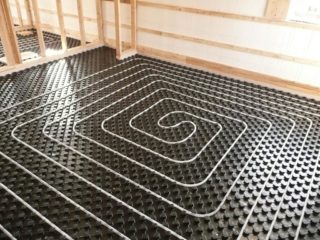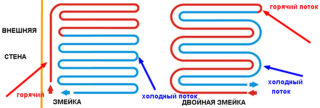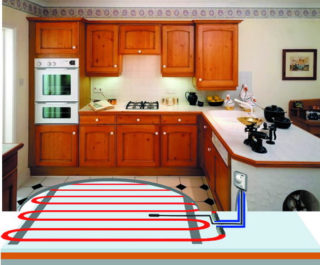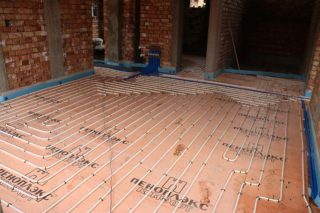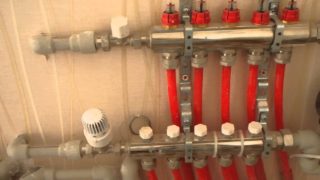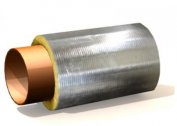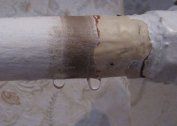There are two main ways of floor heating - electric and water. In the latter, hot water flowing through the pipeline serves as a coolant. Of the various pipe laying schemes for heating a room, a snail floor heating is considered the most effective.
Main advantages and disadvantages
Any technical solution has its strengths and weaknesses - underfloor heating is no exception.
Advantages of water heating:
- the best level of comfort among heating systems;
- long term of operation;
- the ability to control the temperature;
- space saving due to the lack of radiators along the walls.
The disadvantages of such a heating system include:
- A prolonged stay in a room with a warm water floor can provoke a relapse of diseases of the musculoskeletal system, in particular, varicose veins.
- It is necessary to use materials with a low heat transfer coefficient (indicated in the material labeling) for the finish coating.
- During installation, about 10 cm of the height of the room is lost.
- The system has high inertia - the room heats up from 3 to 5 hours.
- Furniture made of any material other than wood, with constant heating, emits harmful substances (the amount is not critical).
- Equipping an apartment with a water floor requires special permission from utilities.
It is impossible to power the underfloor heating from central heating - an autonomous boiler is required.
Snail or snake - which is better
When installing water heating pipes, one of the two most common schemes is used - a snail or a snake.
Laying a warm floor with a snail is considered simpler. Installation of this scheme can be carried out independently, without involving specialists. When laying the floor heating tubes, energy losses are smoothed out, there is no temperature “zebra”.
The snake is less efficient - the coolant is supplied on the one hand, as it moves away from the mixing unit, the temperature decreases markedly - the opposite half of the room heats up significantly worse. You can lay the pipes with a double snake, which partially alleviates heat loss. The minus of the snake is the complexity of installation due to bending of pipes by 180 ° plus high laboriousness.
The snake is not laid in sanitary facilities, where it is necessary to bypass various appliances and plumbing.
Snail laying pattern
With the system of spiral mounting of water heating pipes, heat carriers with hot water and a cooling return are located parallel to each other over the entire area of the room. The step between structural elements can be changed - for example, reduced near an external wall, but this requires additional accurate calculation. In cold areas, it is advisable to have a separate snail.
Norms and Rules
Installation of water heating pipes is most often carried out using a concrete screed, which makes it difficult to eliminate design errors. Therefore, all calculations, the choice of pipes, pump and mixing unit and installation schemes require a serious approach.
When calculating floor heating, certain rules should be taken into account:
- places of permanent location of furniture (walls, sofas, etc.) and plumbing fixtures (toilet bowl, bidet, etc.) are bypassed; pipes are not mounted there;
- the average area of 1 kennel should not exceed 15 m² (in order to maintain pressure in the system);
- several large snails are placed for heating large areas;
- the approximate consumption of pipes at a step of 10 cm is 10 m / m²;
- min bending radius of the water pipe is considered as five of its diameters;
- with good thermal insulation in mild climates, the pipe pitch can be increased to 15 cm.
The cochlea works most efficiently at an initial coolant temperature of 55 ° C and a difference in the range of 5-10 ° C.
The sequence of installation of the cochlea
The most popular is the laying method, in which the installed water heating system is poured with concrete mortar.
Work execution order:
- The rough base is cleaned and leveled.
- Thermal insulation plates are placed, the joints are hidden with mounting foam, summer damper is laid in the calculated places, which helps to prevent cracking of the heavy as a result of heating.
- A reinforcing mesh is mounted above the surface (raised by 2-3 cm).
- On the grid place mats for laying or a base for fastening pipes.
- According to the scheme of the snail, heat-insulated floor pipes are placed and fixed. To do this, use clamps, clips, harpoons or latches (mount for panels).
- The system is filled with coolant and pressure tested - while the pipes take the working size.
- Pour the system with concrete.
- The surface is covered with the selected topcoat - linoleum, tile.
Problems with the operation of the heating system by the cochlea are the result of violations during installation.
Connection to Collector Wiring
The beam connection scheme allows for precise adjustment of the coolant, but it is complex and requires an additional number of pipes and fittings.
With a large area, heating is carried out not by one large snail, but divided into several.
All heating units are connected not with the boiler, but with a collector, which is also called a heating comb. The device allows you to evenly adjust the flow of coolant along spirals of different lengths.
Choosing a comb, they are guided by the number of circuits requiring connection. The collector is better to take one circuit more and drown out the excess.
For underfloor heating systems, one of two types of comb can be used:
- with manual adjustment;
- with automatic regulation.
If underfloor heating is the only type of heating, a manual comb is enough. If the room is heated by batteries, and floor heating is an auxiliary heat source, it will be extremely difficult to manually adjust the collector, it is better to choose the automatic option.
The heating combs are placed in the manifold cabinet, the supply is usually mounted on top, and the return - on the bottom.
For the operation of underfloor water heating, forced circulation of the coolant using a pump is necessary.
Heating with a water floor mounted by a snail evenly distributes heat throughout the area, is safe to use and economical even in rooms with high ceilings. The absence of visible heating elements makes such a heating system aesthetic and convenient for any interior.
